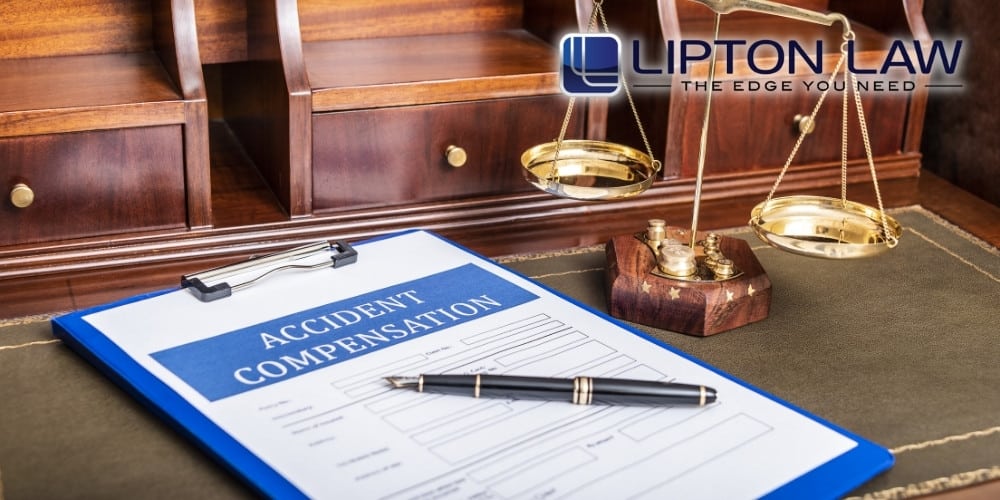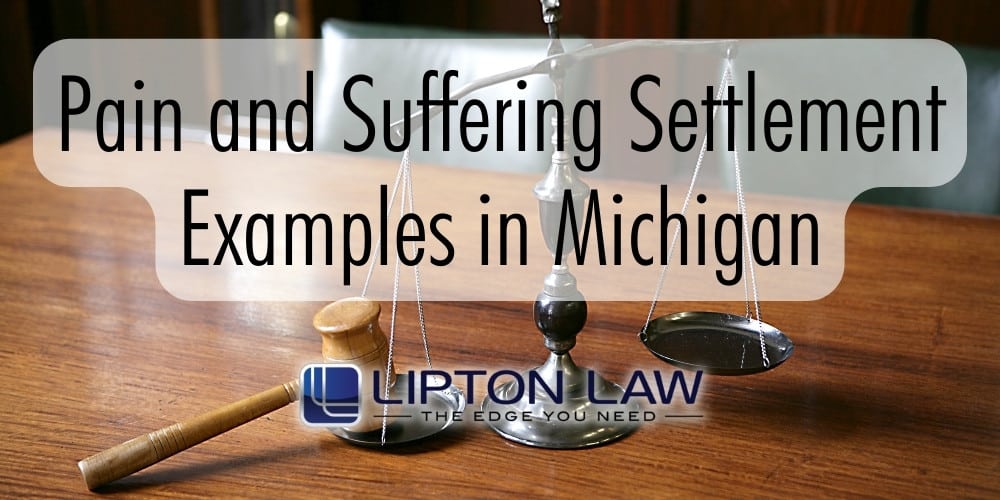When someone else’s negligence causes emotional or physical injuries to another person, the victim may be able to sue them for pain and suffering. On top of the financial challenges that injury victims face, such as medical bills, lost wages, and other economic damages, they often face mental and emotional challenges. These victims deserve compensation for their emotional distress, mental anguish, and other non-economic damages. In the following blog, we outline pain and suffering settlement examples in Michigan, as well as what goes into valuing these settlements.
At Lipton Law, our Michigan personal injury attorneys understand that accidents can leave victims with much more than just bodily injury. Many people who go through traumatic experiences suffer mental and emotional challenges on top of their severe injuries. In fact, their lives may be forever changed by emotional trauma. We firmly believe that pain and suffering damages deserve fair compensation. If you have endured mental or emotional suffering in your personal injury case, our law firm is here for you. To schedule your free consultation with us, please call our office at 248-557-1688 today.
What Is Pain and Suffering?
Pain and suffering is a legal term that refers to the physical pain, emotional distress, and mental anguish that injury victims may endure in a personal injury claim. It is an important element of any personal injury settlement, as it makes up a significant portion of the non-economic damages. Personal injury victims can seek pain and suffering settlements in their cases. Family members of the deceased can also seek a pain and suffering award for the loss of their loved one.
Examples of Pain and Suffering

There are many examples of pain and suffering damages, and these examples are split into two major categories. These categories are physical pain and suffering and mental or emotional pain and suffering. In the following two sections, we outline examples in both categories.
Physical Pain and Suffering
Physical injuries have the potential to not only cause excruciating pain in the moment, but also chronic pain that lasts for weeks, months, or even years. Certain permanent injuries also have permanent pain. Below, we list examples of certain injuries and medical conditions that could cause physical pain and suffering.
- Traumatic brain injury
- Broken arm or leg
- Certain catastrophic injuries
- Back injuries
- Neck injuries
- Spinal cord injuries
- Internal organ damage
- Headaches and migraines
- Nerve damage
- Spinal cord injuries
- Paralysis
- Amputations
- Scarring or disfigurement
- Loss of hearing or eyesight
The effects of many of the above conditions can affect someone for long periods of time, if not for the rest of their life.
Emotional Pain and Suffering
Psychological trauma and emotional distress can also have a significant impact on someone’s life after a serious car accident or another personal injury case. Common examples of emotional pain and suffering damages include the following.
- Post-traumatic stress disorder (PTSD)
- Grief
- Loss of quality of life
- Loss of consortium
- Fear and worry
- Anxiety and depression
- Insomnia
- Changes in cognitive functioning
- Panic attacks
- Other forms of psychological trauma
Pain and Suffering in a Wrongful Death Lawsuit

If a personal injury lawsuit arises from a situation in which you lost a loved one, you have the right to seek pain and suffering compensation for loss of consortium. Loss of consortium is a unique form of pain and suffering that family members experience when they lose a loved one. Examples of loss of consortium include losses of the following.
- Companionship
- Parental relationship and guidance
- Intimacy with a spouse
- Household income and services
- Affection and love
Types of Personal Injury Cases That Could Lead to Pain and Suffering Settlements
An experienced personal injury lawyer will understand that pain and suffering damages can arise from a multitude of case types. It may be possible for you to receive a pain and suffering settlement for the following personal injury claims.
- Car accidents
- Truck accidents
- Motorcycle accidents
- Bus accidents
- Pedestrian accidents
- Dog bite injuries
- Medical malpractice cases
- Nursing home abuse
- Back and spinal cord injuries
- Catastrophic injuries
- Slip and fall accidents
- Defective product cases
- Wrongful death lawsuits
Keep in mind that this is not an exhaustive list of all personal injury lawsuits that could include a pain and suffering settlement.
What Is a Fair Settlement for Pain and Suffering?
This largely depends on the facts of your case, as well as the severity of your injuries. The best way to determine a fair settlement for pain and suffering is to speak with personal injury attorneys who have experience with cases like yours. Personal injury lawyers have the knowledge and training necessary to properly estimate your losses. Generally, we take the following factors into consideration.
- The level of pain experienced by the victim
- The pain and discomfort resulting from the medical treatment needed
- Negative side effects resulting from the pain and suffering, such as insomnia, PTSD, depression, or anxiety
- Impact of the injuries on the victim’s quality of life
In the following sections, we explain how most attorneys go about calculating pain and suffering damages.
How to Calculate Pain and Suffering Damages

There are two main techniques that attorneys use to calculate this form of non-economic damages. These techniques are the multiplier method and the per diem method.
Per Diem Method
“Per diem” is a Latin phrase that means “per day.” As you can probably imagine, the per diem method involves assigning a specific dollar amount to each day that the victim dealt with their pain and suffering. Unfortunately, it is difficult to come up with a dollar amount or a daily rate in this way. This is largely why most attorneys opt for the multiplier method when they need to value a pain and suffering settlement.
Multiplier Method
The multiplier method is a much more common way to determine an appropriate pain and suffering award. It essentially adds up a victim’s medical bills from the accident and multiplies the sum by a number between 1.5 and 5. How high the multiplier number is depends on the following factors.
- Severity of the injuries suffered by the accident victim
- How clear fault is in the accident
- Impact on the victim’s daily life
- How likely a full and fast recovery is for the victim
How Can a Personal Injury Attorney Help Me?
As a personal injury victim, you’ve already got a lot on your plate. You’re dealing with medical bills, lost wages, medical treatment, the insurance company, and so much more. Hiring a personal injury lawyer can take a great deal of weight off your shoulders. At Lipton Law, we will handle the insurance company, the paperwork, gathering the evidence, and litigating your case. In other words, we deal with all the heavy lifting while you focus on your recovery.
Average Settlement for Pain and Suffering
Unfortunately, there is no real average settlement for pain and suffering. Even if it were possible to calculate an average, this does you no good. Looking at an average settlement amount is rarely helpful in personal injury cases. This is because all accident victims have unique facts and circumstances surrounding their cases. Therefore, an attorney will take these unique facts into account when determining the value of your claim. Even if your case seems similar to someone else’s on the surface, the underlying details could be completely different.
Rather than looking for the average payouts for cases like yours, consider scheduling a free consultation with our Michigan personal injury lawyers. We can take an in-depth look at your case and give you a rough estimate of what you could receive in a pain and suffering settlement.
How to Prove Pain and Suffering

Regarding how to prove pain and suffering, your attorney will gather all relevant evidence in order to strengthen your claim. Some forms of evidence that we will gather to support your case include the following.
- Medical records and medical expenses
- Photographs and videos of your injuries
- Treatment records
- Records of how much work you missed
- Mental health records
- Documentation of your mental state
- Statements from close friends and family members
Contact the Michigan Injury Lawyers at Lipton Law
At Lipton Law, we fully believe that your pain and suffering deserve full and fair compensation. Tangible and intangible losses are both important, as is proving pain and suffering in your personal injury claim. If you’re looking for personal injury attorneys with extensive experience fighting for the rights of their clients, look no further. We strive to protect the best interests of our clients during every step in the claims process. If you have endured pain and suffering as an injury victim, our law firm is here for you. To schedule your free case evaluation with us, please call our office at 248-557-1688 today.

